- Table of Contents
- Related Documents
-
| Title | Size | Download |
|---|---|---|
| 03-Web overview | 201.40 KB |
Contents
This chapter describes the Web interface, functions available on the Web interface, Web user levels you must have to perform a function, and common icons and buttons on the Web pages.
Web interface
The Web interface consists of the navigation tree, title area, and body area.
Figure 1 Web-based configuration interface
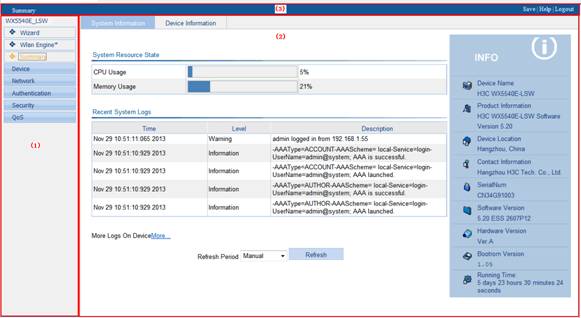
|
(1) Navigation area |
(2) Body area |
· Navigation area—Organizes the Web-based NM function menus in the form of a navigation tree, where you can select function menus as needed. The result is displayed in the body area. The Web network management functions not supported by the device are not displayed in the navigation area.
· Body area—The area where you can configure and display a function.
· Title area—On the left, displays the path of the current configuration interface in the navigation area; on the right, provides the Save button to quickly save the current configuration, the Help button to display the Web related help information, and the Logout button to log out of the Web interface.
Web user level
Web user levels, ranging from low to high, are visitor, monitor, configure, and management. A user with a higher level has all the operating rights of a user with a lower level.
· Visitor—Users can use the network diagnostic tools ping and Trace Route, but they can neither access the device data nor configure the device.
· Monitor—Users can only access the device data, but they cannot configure the device.
· Configure—Users can access device data and configure the device, but they cannot upgrade the host software, add/delete/modify users, or backup/restore configuration files.
· Management—Users of this level can perform any operations to the device.
Web-based NM functions
A user level in Table 1 indicates that users of this level or users of a higher level can perform the corresponding operations.
Table 1 Web-based NM function description
|
Function menu |
Description |
User level |
||
|
Wizard |
IP Setup |
Perform quick configuration of the device. |
Management |
|
|
Summary |
System Information |
Display the system information, system resource status, and the recent system operation logs. |
Monitor |
|
|
Device Information |
Display the port, power supply, and fan information of the device. |
Monitor |
||
|
Device |
Basic |
System Name |
Display and configure the system name. |
Configure |
|
Web Idle Timeout |
Display and configure the idle timeout period for logged-in users. |
Configure |
||
|
System Time |
System Time |
Display the system date and time. |
Monitor |
|
|
Configure the system date and time |
Configure |
|||
|
Time Zone |
Display configurations about system time zone and daylight saving time. |
Monitor |
||
|
Configure system time zone and daylight saving time. |
Configure |
|||
|
Network Time Protocol |
Display the synchronization status of system clock and network time configuration information. |
Monitor |
||
|
Configure the network time. |
Configure |
|||
|
Device Maintenance |
Software Upgrade |
Configure to upload upgrade file from local host, and upgrade the system software. |
Management |
|
|
Reboot |
Configure to reboot the device. |
Management |
||
|
Diagnostic Information |
Generate diagnostic information file, and view or save the file to local host. |
Management |
||
|
Syslog |
Loglist |
Display and refreshes system logs. |
Monitor |
|
|
Clear system logs. |
Configure |
|||
|
Loghost |
Display and configure the loghost. |
Configure |
||
|
Log Setup |
Display and configure the buffer capacity, and interval for refreshes system logs. |
Configure |
||
|
Configuration |
Backup |
Back up the configuration file to be used at the next startup from the device to the host of the current user. |
Management |
|
|
Restore |
Upload the configuration file to be used at the next startup from the host of the current user to the device. |
Management |
||
|
Save |
Save the current configuration to the configuration file to be used at the next startup. |
Configure |
||
|
Initialize |
Restore the factory default settings. |
Configure |
||
|
File Manage |
File Manage |
Manage files on the device, such as displaying the file list, downloading a file, uploading a file, removing a file, and setting the main boot file. |
Management |
|
|
Port Management |
Summary |
Display port information by features. |
Monitor |
|
|
Detail |
Display feature information by ports. |
Monitor |
||
|
Setup |
Create, modify, delete, or enable/disable a port, and clear port statistics. |
Configure |
||
|
Port Mirroring |
Summary |
Display the configuration information of a port mirroring group. |
Monitor |
|
|
Create |
Create a port mirroring group. |
Configure |
||
|
Remove |
Remove a port mirroring group. |
Configure |
||
|
Modify Port |
Configure ports for a mirroring group. |
Configure |
||
|
Users |
Summary |
Display the brief information about FTP and Telnet users. |
Monitor |
|
|
Super Password |
Configure a password for a lower-level user to switch from the current access level to the management level. |
Management |
||
|
Create |
Create an FTP or Telnet user. |
Management |
||
|
Modify |
Modify FTP or Telnet user information. |
Management |
||
|
Remove |
Remove an FTP or a Telnet user. |
Management |
||
|
Switch To Management |
Switch the current user level to the management level. |
Visitor |
||
|
Loopback |
Loopback |
Perform loopback tests on Ethernet interfaces. |
Configure |
|
|
VCT |
VCT |
Check the status of the cables connected to Ethernet ports. |
Configure |
|
|
Flow Interval |
Port Traffic Statistics |
Display the number of packets and bytes received and sent by the interface, and the bandwidth usage within a specified time interval. |
Monitor |
|
|
Interval Configuration |
Set an interval for collecting traffic statistics on interfaces. |
Configure |
||
|
Storm Constrain |
Storm Constrain |
Display and set the interval for collecting storm constrain statistics. Display, create, modify, and remove the port traffic threshold. |
Configure |
|
|
RMON |
Statistics |
Display, create, modify, and clear RMON statistics. |
Configure |
|
|
History |
Display, create, modify, and clear RMON history sampling information. |
Configure |
||
|
Alarm |
View, create, modify, and clear alarm entries. |
Configure |
||
|
Event |
View, create, modify, and clear event entries. |
Configure |
||
|
Log |
Display log information about RMON events. |
Configure |
||
|
Energy Saving |
Energy Saving |
Display and configure the energy saving settings of an interface. |
Configure |
|
|
SNMP |
Setup |
Display and refresh SNMP configuration and statistics information. |
Monitor |
|
|
Configure SNMP. |
Configure |
|||
|
Community |
Display SNMP community information. |
Monitor |
||
|
Create, modify, and delete an SNMP community. |
Configure |
|||
|
Group |
Display SNMP group information. |
Monitor |
||
|
Create, modify, and delete an SNMP group. |
Configure |
|||
|
User |
Display SNMP user information. |
Monitor |
||
|
Create, modify, and delete an SNMP user. |
Configure |
|||
|
Trap |
Display the status of the SNMP trap function and information about target hosts. |
Monitor |
||
|
Enable or disable the SNMP trap function, or create, modify, and delete a target host. |
Configure |
|||
|
View |
Display SNMP view information. |
Monitor |
||
|
Create, modify, and delete an SNMP view. |
Configure |
|||
|
Interface Statistics |
Interface Statistics |
Display and clear the statistics information of an interface. |
Configure |
|
|
Network |
VLAN |
Select VLAN |
Select a VLAN range. |
Monitor |
|
Create |
Create VLANs. |
Configure |
||
|
Port Detail |
Display the VLAN-related details of a port. |
Monitor |
||
|
Detail |
Display the member port information of a VLAN. |
Monitor |
||
|
Modify VLAN |
Modify the description and member ports of a VLAN. |
Configure |
||
|
Modify Port |
Change the VLAN to which a port belongs, the connection type and PVID of the port. |
Configure |
||
|
Remove |
Remove VLANs. |
Configure |
||
|
VLAN Interface |
Summary |
Display information about VLAN interfaces by address type. |
Monitor |
|
|
Create |
Create VLAN interfaces and configure IP addresses for them. |
Configure |
||
|
Modify |
Modify the IP addresses and status of VLAN interfaces. |
Configure |
||
|
Remove |
Remove VLAN interfaces. |
Configure |
||
|
Voice VLAN |
Summary |
Display voice VLAN information globally or on a port. |
Monitor |
|
|
Setup |
Configure the global voice VLAN. |
Configure |
||
|
Port Setup |
Configure a voice VLAN on a port. |
Configure |
||
|
OUI Summary |
Display the addresses of the OUIs that can be identified by voice VLAN. |
Monitor |
||
|
OUI Add |
Add the address of an OUI that can be identified by voice VLAN. |
Configure |
||
|
OUI Remove |
Remove the address of an OUI that can be identified by voice VLAN. |
Configure |
||
|
MAC |
MAC |
Display MAC address information. |
Monitor |
|
|
Create and remove MAC addresses. |
Configure |
|||
|
Setup |
Display and configure MAC address aging time. |
Configure |
||
|
MSTP |
Region |
Display information about MST regions. |
Monitor |
|
|
Modify MST regions. |
Configure |
|||
|
Global |
Set global MSTP parameters. |
Configure |
||
|
Port Summary |
Display the MSTP information of ports. |
Monitor |
||
|
Port Setup |
Set MSTP parameters on ports. |
Configure |
||
|
Link Aggregation |
Summary |
Display information about aggregated interface, and information about member ports. |
Monitor |
|
|
Create |
Create link aggregation groups. |
Configure |
||
|
Modify |
Modify link aggregation groups. |
Configure |
||
|
Remove |
Remove link aggregation groups. |
Configure |
||
|
LACP |
Summary |
Display information about LACP-enabled ports and their partner ports. |
Monitor |
|
|
Setup |
Set LACP priorities. |
Configure |
||
|
LLDP |
Port Setup |
Display the LLDP configuration information, local information, neighbor information, statistics information, and status information of a port. |
Monitor |
|
|
Modify LLDP configuration on a port. |
Configure |
|||
|
Global Setup |
Display global LLDP configuration information. |
Monitor |
||
|
Configure global LLDP parameters. |
Configure |
|||
|
Global Summary |
Display global LLDP local information and statistics. |
Monitor |
||
|
Neighbor Summary |
Display global LLDP neighbor information. |
Monitor |
||
|
Service |
Service |
Display the states of services: enabled or disabled. |
Configure |
|
|
Enable/disable services, and set related parameters. |
Management |
|||
|
Diagnostic Tools |
Ping |
Ping an IP address and display the operation result. |
Visitor |
|
|
Trace Route |
Perform trace route operation and display the operation result. |
Visitor |
||
Common items on the Web pages
Buttons and icons
Table 2 Commonly used buttons and icons
|
Button and icon |
Description |
|
|
Applies the configuration on the current page. |
|
|
Cancels the configuration on the current page, and returns to the corresponding list page or the Device Info page. |
|
|
Refreshes the current page. |
|
|
Clears all entries in a list or all statistics. |
|
|
Adds an item. |
|
|
Removes the selected items. |
|
|
Selects all the entries in a list, or selects all ports on the device panel. |
|
|
Clears all the entries in a list, or clears all ports on the device panel. |
|
|
Buffers settings you made and proceeds to the next step without applying the settings. This button is typically present on the configuration wizard. |
|
|
Buffers settings you made and returns to the previous step without applying the settings. This button is typically present on the configuration wizard. |
|
|
Applies all settings you made at each step and finishes the configuration task. This button is typically present on the configuration wizard. |
|
|
Accesses a configuration page to modify settings. This icon is typically present in the Operation column in a list, |
|
|
Deletes an entry. This icon is typically present in the Operation column in a list, |
Page display
The Web interface can display contents by pages, as shown in Figure 2. You can set the number of entries displayed per page, and view the contents on the first, previous, next, and last pages, or go to any page that you want to check.
|
|
NOTE: A list can contain a maximum of 20000 entries if displayed in pages. |
Figure 2 Content display by pages
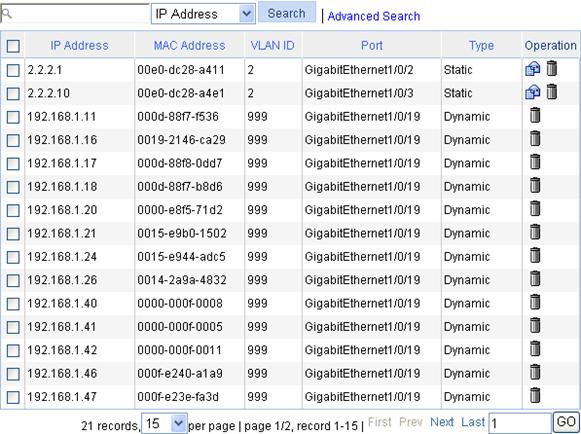
Search function
· Basic search—As shown in Figure 2, input the keyword in the text box above the list, select a search item from the list and click Search to display the entries that match the criteria. Figure 3 shows an example of searching for entries with VLAN ID 2.
Figure 3 Basic search function example

· Advanced search—Advanced search function: As shown in Figure 2, you can click the Advanced Search link to open the advanced search page, as shown in Figure 4. Specify the search criteria, and click Apply to display the entries that match the criteria.
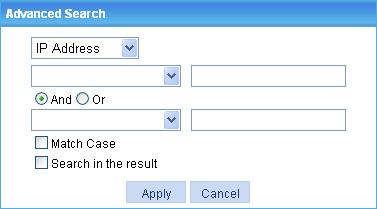
Take the ARP table shown in Figure 2 as an example. If you want to search for the ARP entries with interface being GigabitEthernet1/0/19, and IP address range being 192.168.1.50 to 192.168.1.59, follow these steps:
1. Click the Advanced Search link, specify the search criteria on the advanced search page as shown in Figure 5, and click Apply. The ARP entries with interface being GigabitEthernet1/0/19 are displayed.
Figure 5 Advanced search function example (1)
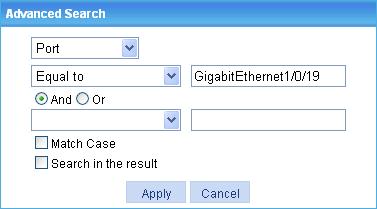
2. Click the Advanced Search link, specify the search criteria on the advanced search page as shown in Figure 6, and click Apply. The ARP entries with interface being GigabitEthernet1/0/19 and IP address range being 192.168.1.50 to 192.168.1.59 are displayed as shown in Figure 7.
Figure 6 Advanced search function example (2)
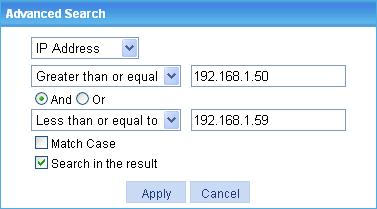
Figure 7 Advanced search function example (3)

Sort function
The Web interface provides you with the basic functions to display entries in certain orders.
On a list page, you can click the blue heading item of each column to sort the entries based on the heading item you selected. After your clicking, the heading item is displayed with an arrow beside it as shown in Figure 8. The upward arrow indicates the ascending order, and the downward arrow indicates the descending order.
Figure 8 Basic sorting function example (based on IP address in the descending order)


